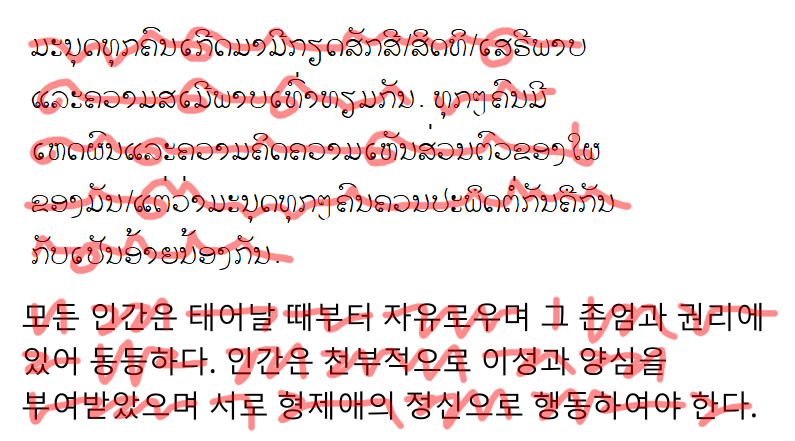Richard W wrote: ↑Sat Dec 09, 2023 7:15 pm
bradrn wrote: ↑Sat Dec 09, 2023 6:20 pm
Moose-tache wrote: ↑Sat Dec 09, 2023 5:32 pm
I think if vowel marks are obligatory, to me that just sounds like another kind of abjad.
Except it would be a
weird abjad, because (a) abjads are defined by not writing the vowels obligatorily, and (b) the vowel marks in Lao are often written in line with the rest of the text, bipartitely in many cases. For instance, /eː/ is ເ◌, /a/ is ◌ະ, /e/ is ເ◌ະ.
Nitpick: ເ◌ະ is /eʔ/. Otherwise, /e/ is ເ◌ັ◌, where the dotted circles represent mandatory consonants.
Ah, thanks! (I know I can count on you to correct me on Indic scripts

)
A graphically clustered consonant is possible for the first slot, e.g. ເຫງັນ 'civet'.
I’m aware.
bradrn wrote: ↑Sat Dec 09, 2023 6:20 pm
Richard W wrote: ↑Sat Dec 09, 2023 5:56 pm
So do you regard Meroitic as an abugidaʔ
I regard Meroitic as yet another in-between system. In fact, it’s almost the reverse of the Lao case: modern Lao is nonlinear but writes every vowel, yet Meroitic is linear while having an inherent vowel. Neither can be unambiguously assigned to one of the ‘traditional’ categories, though like I said I’m inclined to define ‘semi-syllabary’ as a new basic category. (Neither quite fits the ‘abugida’ case, since the prototypical abugida has inherent vowels and writes the remaining vowels nonlinearly.)
'Semisyllabary' means a system with a mix of phonetic syllables and alphabetic symbols. I think the Iberian alphabets are the prototypical examples.
On reflection, I got confused by the fact that Tartessian uses CV-V combinations similar to Old Persian and Meroitic, and I incorrectly assumed that’s what was meant by a ‘semi-syllabary’. But I see now that the other Paleohispanic scripts are genuine syllabary–alphabet combinations.
Not all abugidas have higgledy-piggledy vowel marks. It's largely a feature inherited from the early Indic alphabets. Canadian Syllabics are orderly, though I don't like calling them an abugida. Meroitic seems to be designed much the same ways as Brahmi or Kharoshthi - strike out the commonest vowel symbol as unnecessary, though for Meroitic it seems to give only a 25% saving.
(Did you perhaps mean ‘early Indic abugidas’?)
You can add Ethiopic to the list — if anything, its vowels are even more higgledy-piggledy than Indic ones. But yes, if you relax the condition that vowels should be diacritical (to form graphical syllabic blocks), then Meroitic certainly qualifies as an abugida.
Ultimately, what this comes down to is that the usual classification just isn’t very good — it ignores some distinctions while leaving other systems unclassified or ambiguous. But I’m already getting some ideas around what a better typology might look like, and I’ll probably post it here once I have a firmer idea about the details.
Richard W wrote: ↑Sat Dec 09, 2023 8:05 pm
Closer to home, we have the Latin script, e.g. in 17th century English with bars through the ascenders and descenders of 'b', 'd' and 'p' to abbreviate 'er' or 'ar'. and a similar device for 'ro' through the letter 'p', and the origin of the combining tilde as an abbreviation for a following 'm' or 'n'. And some Germanic languages had vertically stacked vowels.
Looking even earlier, medieval script was chock-full of scribal abbreviations, which is why
record type exists. But this feels to me like a slightly different flavour of nonlinearity, if that makes any sense.
I'm not sure why you think Hangeul takes non-linearity further. It's block by block, top left, right, below, further below - just a series of semi-circles. Lao has tone marks above, whereas the vowel may be below, not just to the left and/or above and/or right.
My reasoning was that, in Lao, the whole text is still effectively a single line — some marks are positioned relatively above, below or to the side of the consonantal letters, but when you read it, you’re still scanning it from left to right with only brief deviations. By contrast, a Hangeul text requires
every single syllable block to be read semicircularly, going from top to bottom and left to right to left, before jumping back to the top of the next block.
But of course this is subjective, and something about which reasonable people can disagree.
And Hangeul is perfectly linear in NFC backing store.
For my purposes I’ll be largely ignoring computer encoding in this thread, for all that it’s a fascinating and intricate topic. (Though I might write a post about it at some point.)
